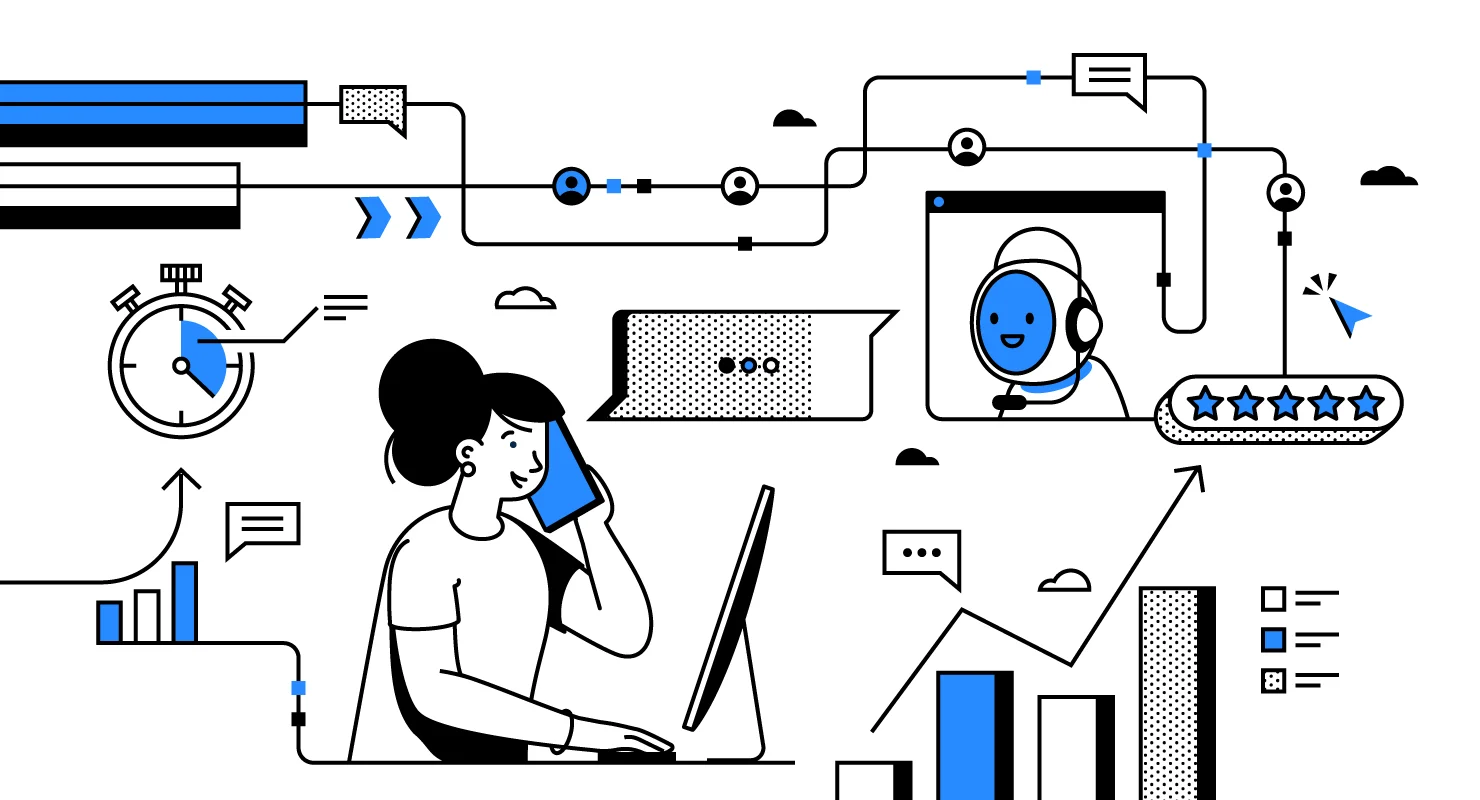According to Gartner, by 2025, customer sentiment will influence over 80% of enterprise decision-making processes, highlighting the critical role of customer sentiment analysis AI in business strategy. In today’s digital age, understanding how customers feel about your brand is more important than ever. Customer sentiment analysis leverages artificial intelligence to sift through vast amounts of textual data, extracting insights about customer opinions, emotions, and attitudes. By interpreting these sentiments, businesses can gain a deeper understanding of their customers’ experiences and expectations.

This blog will delve into the workings of customer sentiment analysis AI, explaining how it harnesses natural language processing and machine learning to decode customer sentiments. We will then explore five real-world customer sentiment analysis use cases that demonstrate its practical applications across various business functions. By the end of this blog, you’ll have a comprehensive understanding of how generative AI in sentiment analysis for brand reputation can transform your business operations and strategy.
What is Customer Sentiment Analysis?

Customer sentiment analysis is the process of identifying and categorizing emotions and opinions expressed in text data, such as customer reviews, social media posts, and survey responses. It involves extracting insights from this data to understand how customers feel about a brand, product, or service. Customer feedback sentiment analysis can determine whether the expressed sentiment is positive, negative, or neutral, providing valuable feedback for businesses.
Impact of AI Integration in Customer Sentiment Analysis
Artificial intelligence significantly enhances customer sentiment analysis AI by automating the complex task of interpreting natural language. Through customer sentiment analysis machine learning algorithms and natural language processing (NLP), AI can analyze vast amounts of text data quickly and accurately. AI-driven sentiment analysis can detect nuances, such as sarcasm or irony, and understand context, making it more effective than traditional methods. This integration allows businesses to gain real-time insights and respond promptly to customer feedback sentiment analysis.
Importance of Customer Sentiment Analysis
Understanding customer sentiment is crucial for businesses because it directly impacts customer satisfaction, loyalty, and overall brand reputation. By leveraging customer service sentiment analysis, companies can:
- Improve Customer Service: Identify common pain points and address them swiftly.
- Enhance Product Development: Gather actionable feedback to refine products and services.
- Manage Brand Reputation: Monitor public perception and respond proactively to negative sentiments using AI in sentiment analysis for brand reputation.
- Optimize Marketing Strategies: Craft targeted marketing campaigns based on customer preferences and emotions.
- Boost Customer Retention: Detect early signs of dissatisfaction and take corrective actions to prevent churn.
By tapping into the emotional pulse of their customer base through AI-enabled customer sentiment analysis, businesses can make data-driven decisions that foster stronger customer relationships and drive long-term success.
How Does AI-Powered Customer Sentiment Analysis Work?
AI-enabled Customer sentiment analysis works through the following process:
1. Data Collection

The first step in customer sentiment analysis AI is gathering data from various sources. This data can come from social media platforms, where customers express their opinions about brands and products, customer reviews on e-commerce websites, feedback surveys, emails, chat transcripts, and voice recordings. Collecting a wide range of data ensures a comprehensive understanding of customer sentiments across different touchpoints. Each data source provides unique insights, such as those found in email sentiment analysis, which can reveal valuable feedback directly from customer communications.
- Social Media: Platforms like Twitter, Facebook, and Instagram offer real-time feedback and public conversations about your brand.
- Customer Reviews: Reviews on sites like Amazon, Yelp, and Google give detailed feedback on customer experiences with specific products or services.
- Surveys and Feedback Forms: Structured feedback through surveys provides direct insights into customer satisfaction and areas needing improvement.
- Emails and Chat Transcripts: Direct communications reveal individual customer issues and sentiments.
- Voice Recordings: Analyzing calls to customer service can uncover nuanced emotions and satisfaction levels.
2. Natural Language Processing (NLP)
Customer sentiment analysis machine learning utilizes Natural Language Processing (NLP) as its backbone. NLP techniques enable computers to understand and interpret human language by breaking down text into manageable components. This involves tokenization, part-of-speech tagging, and syntactic parsing. Through NLP, AI systems can identify sentiment-bearing words, phrases, and the context in which they are used, distinguishing between different emotions and opinions expressed by customers.
NLP processes text data through several stages:
- Preprocessing: Cleaning and organizing raw data, such as removing stop words and normalizing text.
- Tokenization: Breaking down text into individual words or phrases.
- Part-of-Speech Tagging: Identifying grammatical elements to understand sentence structure.
- Named Entity Recognition (NER): Detecting entities like names, dates, and locations for context.
- Sentiment Detection: Recognizing sentiment-laden words and phrases, considering context to avoid misinterpretation (e.g., sarcasm).
3. Machine Learning Algorithms
Once the text data is processed through NLP, machine learning algorithms come into play in customer sentiment analysis AI. These algorithms are trained on vast datasets to recognize patterns and classify sentiments as positive, negative, or neutral. They use various models, such as decision trees, support vector machines, and neural networks, to analyze text and predict sentiment accurately. Advanced models can also detect nuances like sarcasm and irony, providing a more precise customer sentiment analysis.
Key machine learning models include:
- Supervised Learning Models: These models are trained on labeled datasets where the sentiment is predefined, allowing them to learn and predict sentiments accurately.
- Unsupervised Learning Models: These models analyze data without predefined labels, clustering similar sentiments and identifying patterns.
- Deep Learning Models: Neural networks, particularly recurrent neural networks (RNNs) and transformers, can handle complex language structures and provide higher accuracy by understanding context and subtleties in text.
4. Real-Time Analysis

One of the key advantages of AI-enabled customer sentiment analysis is its ability to provide real-time insights. Traditional sentiment analysis methods often involve significant time lags, making it challenging for businesses to respond promptly. With Generative AI for customer sentiment analysis, data is continuously collected and analyzed in real-time, enabling businesses to monitor customer sentiments as they evolve. This capability allows for immediate actions, such as addressing a negative review quickly or capitalizing on positive feedback during a marketing campaign.
The strategic benefits of real-time analysis include:
- Proactive Customer Service: Quickly resolving issues can turn dissatisfied customers into loyal advocates.
- Dynamic Marketing Adjustments: Adapting campaigns on-the-fly based on current sentiment trends can increase effectiveness.
- Crisis Management: Identifying and addressing negative trends before they escalate into larger issues helps protect brand reputation.
- Product Feedback Loop: Immediate insights into product reception can guide iterative improvements and new feature development.
By integrating these components, Generative AI in sentiment analysis for brand reputation transforms vast amounts of unstructured data into actionable insights, helping businesses understand and respond to their customers effectively and efficiently. This strategic approach not only enhances customer satisfaction but also drives business growth by aligning products and services more closely with customer needs and preferences.
5 Use Cases of AI-Enabled Customer Sentiment Analysis
AI-enabled customer sentiment analysis can be utilized in the following use cases:
1. Improving Customer Service

Problem Identification
Customer service sentiment analysis can detect issues in customer service interactions by analyzing text and voice data from customer service channels. By evaluating the sentiment of these interactions, customer sentiment analysis AI can pinpoint recurring complaints, identify negative sentiment trends, and flag conversations where customers express frustration or dissatisfaction. For instance, if multiple customers consistently report long wait times or unresolved issues, voice call sentiment analysis will highlight these problems, enabling businesses to address them promptly.
Solution Implementation
Once problems are identified, businesses can implement solutions based on insights gained from customer sentiment analysis machine learning. For example:
- Training Customer Service Representatives: Using sentiment data to tailor training programs, focusing on areas where negative sentiments are most prevalent.
- Improving Response Times: Adjusting staffing levels or optimizing processes to reduce wait times and improve customer satisfaction.
- Automating Responses: Deploying AI chatbots to handle common queries, allowing human agents to focus on more complex issues.
2. Product Development and Enhancement
Customer Feedback
AI-enabled customer sentiment analysis can sift through vast amounts of customer feedback from reviews, surveys, and social media to identify specific features or aspects of a product that customers love or dislike. By quantifying and categorizing this feedback, businesses can make informed decisions on product enhancements. For example, if customers frequently praise a particular feature, it might be worth emphasizing and expanding it in future versions. Conversely, if a common complaint arises, addressing it can lead to significant improvements in customer satisfaction. Customer feedback analysis provides valuable insights that drive these improvements, ensuring businesses stay aligned with customer expectations.
Market Trends
By analyzing sentiment data over time, businesses can identify emerging market trends and customer demands. Generative AI in sentiment analysis for brand reputation can track changes in sentiment regarding certain product categories or features, providing insights into shifting consumer preferences. This can help businesses stay ahead of the competition by adapting their product offerings to meet current market trends. For instance, if sentiment analysis reveals growing interest in eco-friendly products, a company might decide to develop more sustainable options.
3. Brand Reputation Management
Monitoring Social Media
AI-powered customer sentiment analysis can continuously monitor social media platforms for mentions of a brand, providing real-time insights into public perception. By tracking brand mentions and associated sentiments, businesses can gauge overall brand health and identify potential issues early. This continuous monitoring helps in understanding how marketing campaigns, product launches, or public relations efforts are being received by the audience.
Crisis Management
In the event of a negative sentiment spike, customer sentiment analysis AI enables businesses to respond swiftly and effectively. For example, if a product defect or a controversial incident leads to negative sentiment on social media, businesses can use sentiment analysis to quickly assess the situation, understand the primary concerns, and develop a response strategy. By addressing negative sentiment proactively, businesses can mitigate potential damage to their reputation.
4. Targeted Marketing Campaigns
Audience Segmentation
Customer sentiment analysis AI allows businesses to segment their audience based on their feelings and preferences. By categorizing customers into different sentiment groups (e.g., highly satisfied, neutral, dissatisfied), businesses can tailor their marketing messages to resonate more effectively with each segment. For instance, a campaign targeting highly satisfied customers might focus on loyalty rewards, while a campaign for dissatisfied customers could offer solutions to their grievances and incentives to regain their trust.
Campaign Optimization
Using insights from customer sentiment analysis machine learning, businesses can optimize their marketing campaigns in real-time. or example, if customer service sentiment analysis reveals that a particular advertisement is generating positive customer sentiment, businesses can allocate more resources to amplify its reach. Conversely, if an ad is not resonating well, businesses can quickly adjust their messaging or strategy. This dynamic approach ensures that marketing efforts are always aligned with customer sentiment, maximizing effectiveness through AI for customer review analysis.
5. Customer Retention Strategies
Identifying At-Risk Customers
Customer sentiment analysis AI can detect early signs of dissatisfaction, allowing businesses to identify customers at risk of churning. By analyzing sentiment in customer interactions, businesses can flag customers who frequently express negative sentiments or complaints. This proactive identification enables businesses to intervene before the customer decides to leave.
Personalized Engagement
Once at-risk customers are identified, businesses can craft personalized engagement strategies to re-engage them. AI enabled customer sentiment analysis provides insights into the specific issues and preferences of these customers, allowing businesses to address their concerns directly. For example, a personalized email addressing a customer’s specific complaint and offering a solution can go a long way in regaining their trust and loyalty. Additionally, personalized offers and incentives can be tailored to each customer’s sentiment profile, making retention efforts more effective.
By leveraging AI-driven sentiment analysis across these customer sentiment analysis use cases, businesses can enhance their customer service, product development, brand reputation, marketing strategies, and customer retention efforts. This comprehensive approach ensures that businesses stay attuned to their customers’ needs and sentiments, driving long-term success and growth through AI in sentiment analysis for brand reputation.
Benefits of Implementing AI-Powered Customer Sentiment Analysis
Enhanced Customer Experience
Implementing generative AI-powered customer sentiment analysis significantly enhances the customer experience by providing deep insights into customer emotions and preferences. When businesses understand how their customers feel, they can tailor their interactions to meet and exceed expectations. For example:
- Personalized Interactions: By knowing whether a customer is happy or frustrated, businesses can personalize their responses to address individual needs more effectively.
- Proactive Issue Resolution: Customer feedback sentiment analysis helps identify potential problems before they escalate, allowing businesses to address them proactively and prevent negative experiences.
- Improved Products and Services: Continuous feedback through customer sentiment analysis machine learning helps refine and improve products and services, ensuring they align with customer desires and expectations.
Data-Driven Decision Making
Customer sentiment analysis AI provides actionable data that drives informed decision-making across various business functions. Instead of relying on intuition or limited feedback, businesses can leverage comprehensive sentiment data to guide their strategies. For instance:
- Marketing Strategies: By analyzing customer feedback analysis using NLP towards different campaigns, businesses can adjust their marketing strategies to better resonate with their audience.
- Product Development: Insights from customer sentiment analysis use cases can highlight which features customers love and which ones need improvement, guiding product development efforts.
- Customer Service Improvements: Data on customer service sentiment analysis can inform training programs and process enhancements, leading to more effective and empathetic customer service.
Competitive Advantage
Understanding how sentiment analysis can be used to improve customer experience gives businesses a significant edge over their competitors. By continually monitoring and analyzing sentiments, companies can stay ahead of market trends and customer expectations. Here’s how it provides a competitive advantage:
- Reputation Management: Proactive AI in sentiment analysis for brand reputation helps businesses manage their online reputation more effectively, addressing negative sentiments swiftly and capitalizing on positive customer sentiment.
- Customer Loyalty: Companies that consistently deliver positive customer experiences build stronger customer loyalty, reducing churn and increasing lifetime value.
- Market Positioning: Insights from customer sentiment analysis AI enable businesses to position their products and services more effectively, aligning with current customer needs and preferences better than competitors.
How Can AI-Enabled Sentiment Analysis Be Used to Improve Customer Experience?
Customer sentiment analysis AI plays a vital role in enhancing customer experience by providing businesses with valuable insights into customer feelings and perceptions. Here are several ways customer service sentiment analysis can be leveraged effectively:
Real-Time Feedback Loop
By continuously monitoring customer sentiments across various channels—such as social media, reviews, and support interactions—companies can gather real-time feedback. This enables them to respond quickly to customer concerns, ensuring issues are addressed before they escalate. AI-enabled customer sentiment analysis tools automate this process, making it easier for businesses to act on customer feedback promptly.
Personalized Customer Interactions
Utilizing customer feedback sentiment analysis allows businesses to tailor their communication based on customer emotions. For instance, if a customer expresses frustration in their feedback, a personalized response that acknowledges their feelings can significantly improve their experience and increase the likelihood of brand loyalty. Implementing AI powered customer sentiment analysis ensures these responses are both timely and relevant.
Identifying Trends and Patterns
Analyzing sentiment over time helps businesses identify trends in customer preferences and behaviors. By understanding which aspects of their service or products elicit positive or negative responses, companies can make informed decisions to enhance offerings and address weaknesses. This approach is integral to customer sentiment analysis machine learning, which allows for deeper insights into customer data.
Enhancing Product Development
Customer feedback sentiment analysis reveals not only what customers like or dislike about a product but also their unmet needs. By incorporating this feedback into the product development cycle, businesses can create offerings that better align with customer expectations, leading to improved satisfaction. The insights gained from AI in sentiment analysis for brand reputation can guide product enhancements effectively.
Optimizing Marketing Strategies
Insights from sentiment analysis enable businesses to craft marketing campaigns that resonate with their audience. By understanding the emotions behind customer sentiments, companies can create messaging that speaks directly to their target market, enhancing engagement and conversion rates. Utilizing customer sentiment analysis use cases can illustrate successful marketing strategies informed by sentiment insights.
Monitoring Brand Health
Sentiment analysis provides an ongoing assessment of brand reputation. By tracking public sentiment, businesses can proactively manage their brand image and address any negative perceptions before they impact customer trust and loyalty. This proactive approach is essential in AI for customer review analysis, helping brands maintain a positive presence in the marketplace.
Conclusion
Customer Sentiment Analysis AI represents a powerful tool in the arsenal of modern businesses, offering unparalleled insights into customer emotions and opinions. By understanding how this technology works and exploring its diverse use cases, companies can harness its potential to enhance customer satisfaction, refine product offerings, and drive strategic decisions. Whether through social media monitoring, customer service enhancement, or product development feedback, AI-enabled customer sentiment analysis is poised to transform how businesses engage with their customers, ultimately fostering stronger, more meaningful relationships.
About Wizr AI
Wizr enhances customer support seamlessly with AI-powered customer service tools. Cx Hub predicts and prevents escalations, while Agent Assist boosts productivity with automated customer service software. Auto Solve handles up to 45% of tickets, freeing agents for complex issues. Cx Control Room analyzes sentiment to guide proactive solutions, maximizing satisfaction and retention. Guided by generative AI for customer support, Wizr prioritizes exceptional customer experiences. To explore how these tools can benefit your business, request a demo of Wizr AI today.
How to Conduct a Customer Satisfaction Analysis: Your CSAT Analysis
Customer satisfaction is necessary in every business that would like to succeed and enjoy the patronage of its customers. Companies…
Call Center Speech Analytics: 6 Use Cases & Best Tools
Call Center Speech Analytics is transforming how businesses understand and enhance customer interactions. This technology allows companies to uncover valuable…
AI-Powered Chatbots vs. Virtual Assistants: Which AI Is Best for
Organizations today are using AI to not just enhance customer engagement but to elevate the quality of service being offered….
The Role of Natural Language Processing (NLP) in Generative AI
There has been significant progress in artificial intelligence over the past decade. Two important technologies that have emerged during this…
Top 9 AI Call Center Software for US SaaS Businesses
Efficient and reliable customer service is a key differentiator in today’s fast-paced SaaS industry. Traditional call centers struggle to meet…
10 Benefits of Automated Ticket Routing for Contact Center
Automated ticket routing is transforming how call centers manage and resolve customer inquiries. By leveraging AI-Driven Ticketing Systems for Contact…






